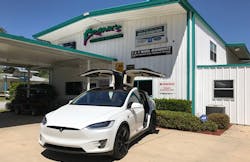When FenderBender last spoke with Frank Rinaudo, in September 2016, the owner of Frank’s Accurate Body Shop in Slidell, La., (“Snap Shop: Frank’s Accurate Body Shop”) had recently implemented lean processes in his shop.
Over the last two years, Rinaudo has put a shop design in place to further increase efficiency.
In 2017, he tweaked the layout of what he describes as his “long, skinny” shop, in an effort to eliminate any wasted motion among technicians. He mapped out potential shop floor layouts multiple times—seeking feedback from his staff throughout the process—before settling on a final design. Eventually, Rinaudo invested nearly $175,000 over the course of six months before finalizing a layout that maximized his facility’s footprint.
Before the renovation, Rinaudo witnessed “a lot of wasted motion,” among his workers. So, in 2017, he says, “the two things we were trying to accomplish were less [unnecessary] movement and more connectivity—like an assembly line. So, when a car is in, say, the light body stage where we’re just finishing minor body work, it only moves 20 feet and then it’s in the primer phase.”
Rinaudo, whose shop now produces a sterling, 98.7 CSI score, explains the steps that he feels shop owners should take after they embark upon a shop floor redesign process.
Retrain employees.
After tweaking his shop’s layout and investing heavily in new equipment like a Garmat High Roof series paint booth, Rinaudo felt it was an ideal time to make sure that his 13-person staff was completely up-to-date with its training.
“We cross-trained a lot of people,” he explains, “so that everybody has a primary position but they can also fill in in other areas if someone is sick or on vacation, or if there’s more need in one area” of the shop.
The move paid off nicely; now Frank’s Accurate Body Shop boasts a cycle time of 7.5 days—down from nearly 11 days prior to 2017.
Invest in equipment.
In his effort to improve the efficiency of his 12,000-square-foot facility, Rinaudo invested $45,000 in tire equipment like mounting and balancing equipment, as well as $2,500 in glass repair equipment like wire-cutout tools and saws. Now, the body shop keeps the lion’s share of its work in-house, and almost never has to sublet work like a glass repair job out to vendors.
“All of that equipment has enabled us to [not] have to wait for a vendor to do it,” Rinaudo notes. “We can do it when it needs to be done, so the car doesn’t stop waiting for that process. Because most glass vendors can’t come out exactly when you need them; you call them and basically wait until it’s convenient for them.”
Assess your workflow often.
In the weeks following Frank’s Accurate Body Shop’s shop floor redesign, Rinaudo found it helpful to often step back and re-assess the workflow his staff produced.
After making slight procedural tweaks, Rinaudo was left with a staff that moved in unison, as efficiently as ever. Once a vehicle rolls out of the paint booth, for example, re-assembly takes place, and detailers soon address the car in a nearby stall.
The shop’s workflow is now, in Rinaudo’s words, “very connected,” while the collision repair facility boasts an annual revenue of $2 million.
The assembly-line setup “also helps in exposing problems,” he explains. “A lot of times, problems are buried, so to speak, and you can’t really see the true problem. But, when you line cars up in a straight line and everything [suddenly] stops, it’s very visual that you have an issue there. You’ve got to be committed to figuring out that issue to prevent those blockages from happening.
“We changed the flow of how cars run through the shop tremendously.”

